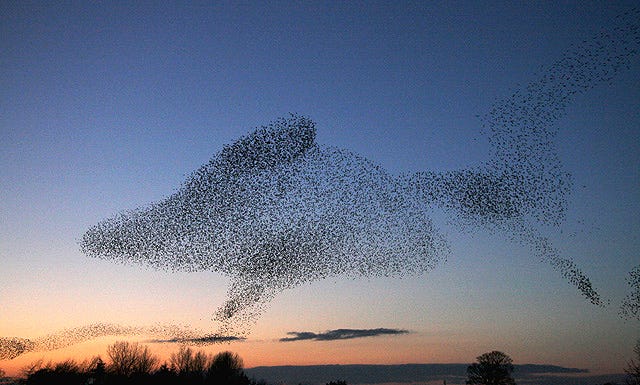Building nature is much easier than calculating it
As shown by the nine lines describing all of nature
Describing the flight of starlings is fun. It is beautiful. And it is a topic of research. In principle, these are all atoms in motion. But the story to understand this example of motion is long. Still, we can enjoy the motion of starlings and its beauty.
Also describing all of textbook physics with 9 lines is fun. Though not so well known, general relativity and particle physics, thus all laws of physics, follow from 9 lines:
The free Motion Mountain physics textbooks explain how all laws of physics follow from these nine lines. Those 9 line are beautiful. They describe all motion ever observed. They describe the motion of particles, the motion of spatial curvature, and the collective motion of systems with many constituents. The 9 lines describe all motion with full precision.
But the 9 lines imply something more. To calculate motion, one needs advanced mathematics, such as the Hilbert Lagrangian of general relativity or the Lagrangian of the standard model. Basically, to calculate motion, one needs a physics degree. In contrast, to understand and to enjoy the 9 lines, a degree is not needed.
The strand tangle model deepens this result: all laws of nature follow from a single principle, the so-called fundamental principle. And there is no need to study physics to grasp and to enjoy it.
Nature is simple to understand, but hard to calculate.
So physics is not needed to enjoy what nature shows us. But the story about the 9 lines goes further. The nine lines show us that it is not necessary to study physics to build a working universe; physics is only necessary to describe what happens in it.
Nature is simple to build, but hard to calculate.
The single line describing nature completely - the fundamental principle - makes the point even more forcefully. Nature is made of fluctuating strands of Planck radius. The radius is so tiny that it makes the strands unobservable. Everything happening in nature follows just one simple rule about these strands: each crossing switch of strands yields Planck’s quantum of action h-bar.
The single line - the fundamental principle - is not so well known yet. But its general idea is already visible in the nine lines: nature works in a simple way.
This conclusion is often hidden or even ignored by us physicists. We tend to imagine that complex mathematics is needed to understand nature. This is not the case. Beware of physicists who tell you this. Understanding physics does not require an intelligence higher than average. The result of unification with strands is strikingly simple:
Creation did not require a superior intelligence.
*
P.S. The simplicity of nature is presented here for physicists and here for non-physicists.





Describing nature requires a physics degree. Creating nature did not.